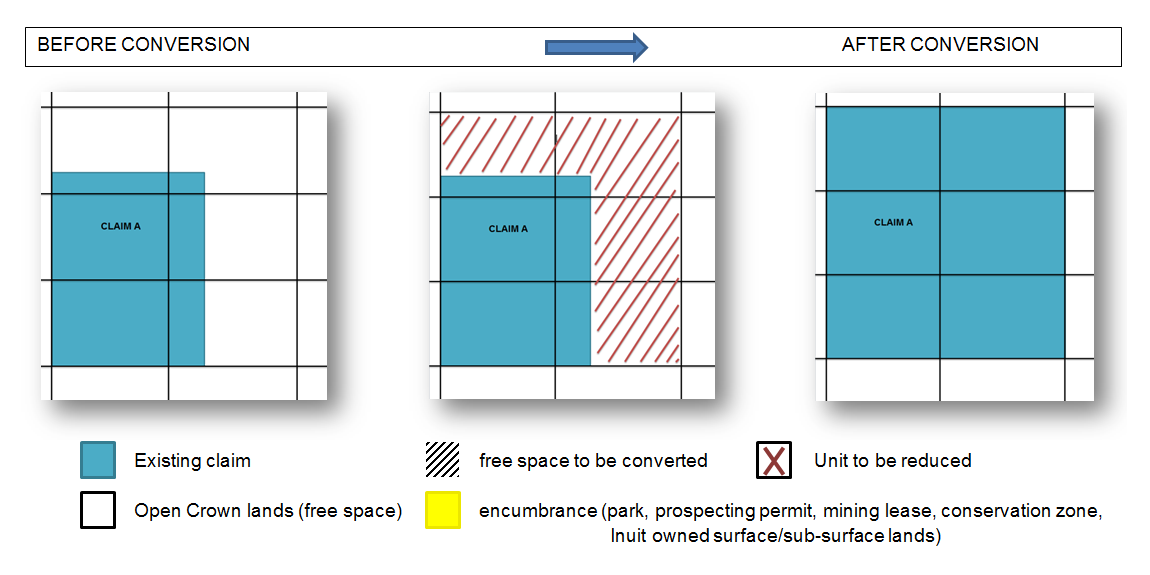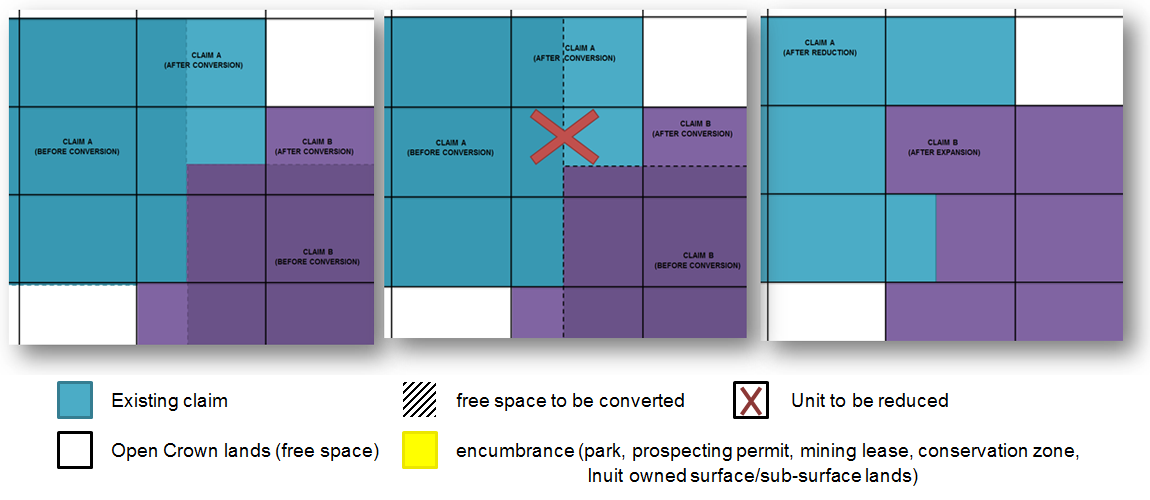Conversion of staked claims into unit claims (Principles and illustrated examples)
On this page

Expansion principle
On January 30, 2021, the 91st day after the Regulations amending the Nunavut Mining Regulations (2020) came into force, there will be a one-time mandatory conversion of all staked (ground) mineral claims except claims subject to a mining lease. All existing (ground staked) claims that are not contiguous to other claims will be expanded to include the entire available area of all grid units they occupy. The objective is to eliminate all areas of open Crown lands (free spaces) within a unit. Multiple ground claims within a unit will be dealt with based on the "first come, first served" principle, in other words the claim that was staked first will be expanded to fill all the open (free) space within a unit. No claim will be reduced as a consequence of the one-time mandatory conversion, but the possibility to reduce a claim will be offered to claim owners afterwards.
1) Claim not contiguous with another claim
An existing claim that is not contiguous with other claims will be expanded to include the entire available area of all grid units it occupies.

Descriptive text
- Before conversion, the existing Claim A takes up a portion of the space, with open Crown lands surrounding it
- After conversion, Claim A covers the existing claim and the open Crown Lands
2) 2 or more claims contiguous without any free space
In a situation where there are 2 or more claims and no free space in a unit, no claim will be expanded. All claims will keep their initial boundaries.

Descriptive text
- Before conversion, Claim A takes up a portion of the land and Claim B takes up a portion. There is no free space to be converted
- After conversion, neither claim was expanded as there was no free space to be converted
3) 2 or more claims and free space in a unit
In a situation where there are two or more claims and free space in a unit, the claim that was staked first will be expanded to include the entire free space in the grid unit the claim occupies.

Descriptive text
- Before conversion, Claim A takes up a portion of the space, and Claim B takes up a smaller portion of the space. Around the claims, there is free space to be converted
- After conversion, the claim that was staked first (Claim A) will expand to take up the free space in the unit of the grid Claim A occupies. The claim that was staked second (Claim B) will take up the free space in the unit of the grid Claim B occupies.
4) 1 or more claims, an encumbrance and free space in a unit
"Encumbrance" is defined as land within a unit that can't be acquired as part of the claim.
In a situation where there are one or more claims, an encumbrance and free space in a unit, the claim that was staked first will be expanded to include the entire free space in the grid unit the claim occupies, excluding the area covered by the encumbrance.
First scenario

Descriptive text
- Before conversion, Claim A and Claim B take up space in the grid adjacent to an encumbrance (the park)
- After conversion, the claim staked first (Claim A) will expand to take up the free space in the grid unit the claim occupies, excluding the park. The claim staked second (Claim B) will take up the remaining free space in the grid unit the claim occupies, excluding the park
Second scenario
Claims subject to a lease issued under the former regulations (2014) will not be converted into unit claims. In a situation where there is a mining lease (encumbrance), an existing claim and free space in a unit, the existing claim will be expanded to include the area of the unit that is not occupied by the leased claim.

Descriptive text
- Before conversion, the existing claim (Claim A) takes up a portion of the grid, and Lease A is an encumbrance
- After conversion, Claim A is expanded to include the free space to be converted, excluding Lease A
Third scenario - a claim, a prospecting permit (encumbrance) and free space
During the one-time conversion period, prospecting permits are considered an "encumbrances".
In a situation where there is a claim, a prospecting permit and free space in the same unit, the claim that was staked first will be expanded to include the entire free space in the grid unit the claim occupies. The expanded claim will not cover the prospecting permit area even if the claim and the permit are owned by the same person.

Descriptive text
- Before conversion, the staked claim takes up a portion of the grid, and the encumbrance (prospecting permit) takes up a portion of the grid
- After conversion, the staked claim is expanded to the rest of the grid, excluding the encumbrance (prospecting permit)
Reduction principle
There is no fee for reduction under the amended regulations and there is no limit to the number of units that can be removed from a claim; however, the units comprised in any claim after reduction needs to be contiguous and "donut claims" are not allowed. In addition, during the first year of the coming into force of the amended regulations, the obligation to have done work on converted claims in order to reduce them does not apply.
1) Claim not contiguous with another claim
In a situation where:
- a claim, not contiguous with any other claim, was expanded to fill all the free space in a unit, and
- the claim holder does not want to keep all the units included in his expanded claim
the claim holder can apply to reduce the area of his claim by removing entire units.

Descriptive text
- In the first image, Claim A (after conversion) and Claim B (before conversion) take up a majority of the grid space
- In the second image, a portion of the grid is identified as a unit of space to be reduced
- In the third image, the space of the claim is reduced
2) 2 claims in a unit
In a situation where there are 2 claims in a unit and one claim holder doesn't want to keep their part of claim in this unit; the claim holder can apply to reduce the area of his claim by removing their part of claim from the unit.
First scenario – Claim holder B applies to reduce their claim part in one of the unit: Claim A will be expanded to fill all the space left by Claim B.

Descriptive text
- In the first image, Claim A and Claim B have 2 claims in 1 unit of the grid
- In the second image, Claim B has applied to reduce their claim in 1 part of the unit, and a portion of the grid is marked as a unit to be reduced
- In the third image, Claim A has expanded to fill the space left by Claim B's reduction
Second scenario – Claim holder A applies to reduce their claim part in one of the unit: Claim B will be expanded to fill all the space left by Claim A.

Descriptive text
- In the first image, Claim A and Claim B have 2 claims in 1 unit of the grid
- In the second image, Claim A has applied to reduce their claim in 1 part of the unit, and a portion of the grid is marked as a unit to be reduced
- In the third image, Claim B has expanded to fill the space left by Claim A's reduction
3) More than 2 claims in a unit
A claim holder can apply to remove their part of a claim from a unit if there are more than 2 claims in the unit. After the reduction of one of the claims, the claim holder that had their claim staked first among the remaining claims will be next to have this claim expanded to fill all the newly free space in the unit.
In the example below, Claim holder A applies to reduce their claim part in the 3 units that are contiguous with Claims B and C. In the unit that comprises the 3 claims, Claim B - which was the second to be staked - will be expanded to fill all the space left by Claim A.

Descriptive text
- In the first image, Claim A, Claim B and Claim C have 3 claims in 1 area of the grid
- In the second image, Claim A has applied to reduce their claim in 1 area of the grid, and a portion of the grid is marked as a unit to be reduced
- In the third image, Claim B and Claim C have expanded to fill the space left by Claim A's reduction
Prospection permits principles
The provisions of the former Nunavut Mining Regulations (2014) on prospecting permits are repealed. It is no longer possible to apply for a prospecting permit. The life cycle of the prospecting permits in the former regulations (2014) will be followed which means that permits are allowed until they are expired or cancelled. A permittee continues to have the exclusive right to acquire a claim within their permit zone if they satisfy the minimal cost of work requirements i.e. at least $0.25 per hectares in the permit. Then, the area covered by the unit claim acquired by the permittee no longer forms part of their permit zone.
1) No unit claim adjacent to the prospecting permit
Boundaries of prospecting permits coincide with longitudes and latitudes – they do not coincide with unit claims grid boundaries. For that reason, units on prospecting permits boundaries typically include a free space. In a situation where there is a prospecting permit and a free space within a unit, the permittee who wish to select a claim within this unit will acquire the full unit as a claim. If a licensee is not the permittee, for instance Mr. C in the example below, this licensee can acquire a claim adjacent to the prospecting permit zone but his claim will exclude the permit area.

Descriptive text
- In the first image, the prospecting permit (Mr. B) takes up a portion of the grid
- In the second image, the middle of the grid is identified as a free space to be converted
- In the third image, the middle of the grid is a staked claim (Mr. B), the bottom left of the grid is a separate staked claim (Mr. C) and the space occupied by the prospecting permit (Mr. B) has been reduced
2) Unit claim adjacent to a prospecting permit
In a situation where an existing unit claim is adjacent to a prospecting permit boundary, the permittee can acquire a unit claim within their prospecting permit zone only. The permittee cannot acquire a claim within the portion of the unit that is covered by the existing claim.

Descriptive text
- In the first image, the staked claim (Mr. S) takes up a portion of the grid, and a prospecting permit (Mr. B) takes up the remainder of the grid
- In the second image, a portion of the grid is identified as a free space to be converted
- In the third image, the staked claim (Mr. S) remains the same, the prospecting permit (Mr. B) is reduced, and the staked claim (Mr. B) fills the space that was reduced